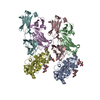+Search query
-Structure paper
| Title | Bispecific antibodies targeting two glycoproteins on SFTSV exhibit synergistic neutralization and protection in a mouse model. |
|---|---|
| Journal, issue, pages | Proc Natl Acad Sci U S A, Vol. 121, Issue 24, Page e2400163121, Year 2024 |
| Publish date | Jun 11, 2024 |
 Authors Authors | Zhen Chang / Dan Gao / Liying Liao / Junqing Sun / Gen Zhang / Xue Zhang / Feiran Wang / Chunrui Li / Babayemi Olawale Oladejo / Shihua Li / Yan Chai / Yongfei Hu / Xuancheng Lu / Haixia Xiao / Jianxun Qi / Zhihai Chen / Feng Gao / Yan Wu /  |
| PubMed Abstract | Severe fever with thrombocytopenia syndrome (SFTS) is an emerging infectious disease with a high fatality rate of up to 30% caused by SFTS virus (SFTSV). However, no specific vaccine or antiviral ...Severe fever with thrombocytopenia syndrome (SFTS) is an emerging infectious disease with a high fatality rate of up to 30% caused by SFTS virus (SFTSV). However, no specific vaccine or antiviral therapy has been approved for clinical use. To develop an effective treatment, we isolated a panel of human monoclonal antibodies (mAbs). SF5 and SF83 are two neutralizing mAbs that recognize two viral glycoproteins (Gn and Gc), respectively. We found that their epitopes are closely located, and we then engineered them as several bispecific antibodies (bsAbs). Neutralization and animal experiments indicated that bsAbs display more potent protective effects than the parental mAbs, and the cryoelectron microscopy structure of a bsAb3 Fab-Gn-Gc complex elucidated the mechanism of protection. In vivo virus passage in the presence of antibodies indicated that two bsAbs resulted in less selective pressure and could efficiently bind to all single parental mAb-escape mutants. Furthermore, epitope analysis of the protective mAbs against SFTSV and RVFV indicated that they are all located on the Gn subdomain I, where may be the hot spots in the phleboviruses. Collectively, these data provide potential therapeutic agents and molecular basis for the rational design of vaccines against SFTSV infection. |
 External links External links |  Proc Natl Acad Sci U S A / Proc Natl Acad Sci U S A /  PubMed:38830098 / PubMed:38830098 /  PubMed Central PubMed Central |
| Methods | EM (single particle) / X-ray diffraction |
| Resolution | 2.51 - 3.3 Å |
| Structure data | EMDB-37756, PDB-8wqw:  PDB-8wsn:  PDB-8wsp:  PDB-8wsu: |
| Chemicals |  ChemComp-NAG:  ChemComp-HOH: |
| Source |
|
 Keywords Keywords | PROTEIN BINDING / Complex / VIRAL PROTEIN / VIRAL PROTEIN/IMMUNE SYSTEM / Virus / Antibody / VIRAL PROTEIN-IMMUNE SYSTEM complex |
 Movie
Movie Controller
Controller Structure viewers
Structure viewers About Yorodumi Papers
About Yorodumi Papers





 dabie bandavirus
dabie bandavirus homo sapiens (human)
homo sapiens (human)